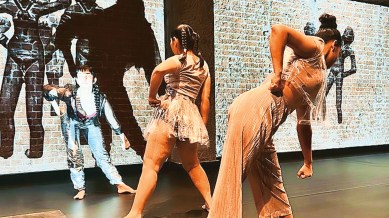Click here to join Express Pune WhatsApp channel and get a curated list of our stories
AI and artists breathe life into Dancing Girl of Mohenjo-Daro
Mandeep Raikhy was intrigued by the ways in which a 10.5 cm bronze statue came to be seen as a dancer, goddess and mother

Excavated from Mohenjo-Daro in 1926, allocated to India after the Partition and, now, living behind thick glass at Delhi’s National Museum, the Dancing Girl of Mohenjo-Daro has had many lives—and any number of stories about why she is the way she is.
An ace dancer and choreographer from Delhi, Mandeep Raikhy, now puts the Dancing Girl at the centre of his latest work and disrupts all the simplistic narratives she has accrued over the years. The piece, Hallucinations of an Artifact, has the Dancing Girl coming to life through dance and artificial intelligence. It opened in Delhi earlier this month and is touring India. The piece will be staged at The Box in Pune on December 20 and 21.
monthly limit of free stories.
with an Express account.
The Dancing Girl is a naked, 10.5 cm tall bronze woman with a penchant for bangles and an elaborate necklace, who is seen as a civilisational figure by India, and also claimed by Pakistan as its own. In May 2023, the International Museum Expo 2023 in Delhi created a “stylised and contemporarised life-size version” of the Dancing Girl dressed in pink and yellow but minus the original’s attitude. It was inaugurated by Prime Minister Narendra Modi.
“The performance looks at the figurine of the Dancing Girl of Mohenjo-Daro, its contested history and its nomenclature and responds to all the narratives that have been attributed to it. She has been called a mother and a goddess, especially by the current government. What if she comes alive in 2023 in a way where she can begin to contest the narratives that have been attributed to it?” says Raikhy.
In Hallucinations of an Artifact, the Dancing Girl goes rogue—she becomes unruly and playful rather than wise and reverent as one would expect of a woman who was born c. 2300-1750 BCE. “I became intrigued that this non-living thing becomes a centre of cultural storm,” says Raikhy, who first encountered the Dancing Girl while learning Bharatanatyam.
Raikhy has always channelled his confusions, anger and curiosity into major dance pieces. His past works, which have pushed the dance canon of the country, include Queen-Size on gender politics, A Male Ant Has Straight Antennae on masculinity, and Anatomy of Belief, which looks at the physicality of faith.
Hallucinations of an Artifact is another collaborative work by Raikhy and visual artist Jonathan O’Hear after Queen Size. “It was over time that I realised that the narratives around the Dancing Girl were all made up. The figurine was given its name by a British person at the time where Indian dance was being banned. In reality, she could really just be resting or just waiting, and it probably has no reference to dance at all,” says Raikhy.
Click here to join Express Pune WhatsApp channel and get a curated list of our stories